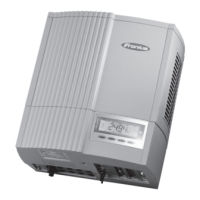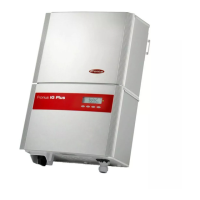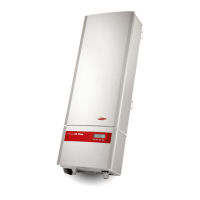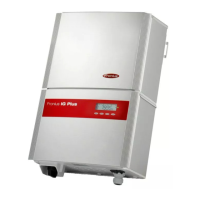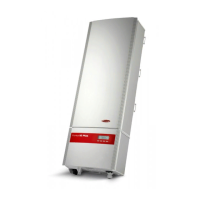Do you have a question about the Fronius IG Plus 100 V-2 and is the answer not in the manual?
Explanation of safety symbols and their meanings.
General safety guidelines and device usage precautions.
Safety measures for people and the inverter.
Sections covering the installation and connection process.
Guidance on selecting an appropriate installation location.
Details on various connection options for the inverter.
Precautions for installing the inverter considering cooling air.
Impact of devices on grid voltage quality.
Requirements for personnel performing servicing and maintenance.
Precautions for safe operation of the device.
General safety principles for inverter operation.
Explanation of galvanic isolation and grid monitoring.
Main tasks of the inverter: DC to AC conversion, management, communication.
How power is reduced to protect the inverter from overheating.
General criteria for selecting an inverter installation location.
Recommendations and restrictions for outdoor inverter installation.
Specific criteria and restrictions for indoor installation.
Diagram and list of connection points on the inverter.
Table of inverters, phases, output, and fuse protection.
Guidelines and criteria for selecting string fuses.
Warnings regarding electric shock and grounding.
How to insert fuses or the grounding kit for module grounding.
Criteria for selecting and inserting string fuses.
Warnings about electric shock when handling option cards.
Steps and indicators for inverter startup and grid feed-in.
Identification and function of display elements and buttons.
Explanation of the LED colors and their meanings.
Inverter self-test and grid synchronization process.
Post-test procedures: grid feed-in and status indicators.
Detailed steps of the inverter's startup test sequence.
Steps to set the currency and energy charge rate.
Steps to set the inverter's date and time.
Procedure to activate or deactivate the setup lock.
How the inverter displays and identifies operational issues.
Status codes requiring intervention from a service technician.
Status codes for measurement errors, relay issues, and display compatibility.
Status codes for normal operation and total failure scenarios.
Safety precautions during maintenance procedures.
Safety warnings for replacing fuses.
Required documentation and procedure for warranty claims.
Explanation of safety symbols and their meanings.
General safety guidelines and device usage precautions.
Safety measures for people and the inverter.
Sections covering the installation and connection process.
Guidance on selecting an appropriate installation location.
Details on various connection options for the inverter.
Precautions for installing the inverter considering cooling air.
Impact of devices on grid voltage quality.
Requirements for personnel performing servicing and maintenance.
Precautions for safe operation of the device.
General safety principles for inverter operation.
Explanation of galvanic isolation and grid monitoring.
Main tasks of the inverter: DC to AC conversion, management, communication.
How power is reduced to protect the inverter from overheating.
General criteria for selecting an inverter installation location.
Recommendations and restrictions for outdoor inverter installation.
Specific criteria and restrictions for indoor installation.
Diagram and list of connection points on the inverter.
Table of inverters, phases, output, and fuse protection.
Guidelines and criteria for selecting string fuses.
Warnings regarding electric shock and grounding.
How to insert fuses or the grounding kit for module grounding.
Criteria for selecting and inserting string fuses.
Warnings about electric shock when handling option cards.
Steps and indicators for inverter startup and grid feed-in.
Identification and function of display elements and buttons.
Explanation of the LED colors and their meanings.
Inverter self-test and grid synchronization process.
Post-test procedures: grid feed-in and status indicators.
Detailed steps of the inverter's startup test sequence.
Steps to set the currency and energy charge rate.
Steps to set the inverter's date and time.
Procedure to activate or deactivate the setup lock.
How the inverter displays and identifies operational issues.
Status codes requiring intervention from a service technician.
Status codes for measurement errors, relay issues, and display compatibility.
Status codes for normal operation and total failure scenarios.
Safety precautions during maintenance procedures.
Safety warnings for replacing fuses.
Required documentation and procedure for warranty claims.
| AC voltage range | 183 - 264 V |
|---|---|
| Weight | 21.6 kg |
| Cooling | Forced air |
| Rated Output Power | 10000 W |
| Nominal AC Output Power | 10000 W |
| Max. apparent AC power | 11000 VA |
| Maximum AC Output Power | 11000 W |




